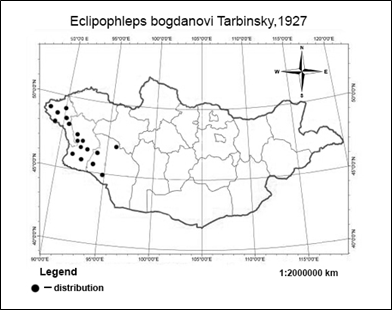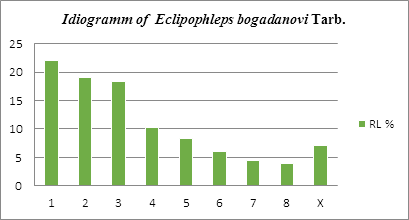Introduction
Eclipophleps bogdanovi Tarb., distributing in the mountainous regions (N 46.83 606° E 92.02 142°,H=2534m) of west Mongolia, can endure the cold, and this kind of grasshopper is the main members which result in the grasshoppers′ calamity in the alpine meadow of west Mongolia. Karyotype analysis is an important study means of Cytogenetics, Taxanomy and Evolutionary theory, and a simple approach to the study of chromosomes. As the basis of the genetic research of grasshoppers, the karyotype and band analysis of grasshoppers recently have achieved a lot. However, there is not any report about the karyotype of Eclipophleps bogadanovi Tarb. In this paper, the karyotype of Eclipophleps bogdanovi Tarb. will be analyzed and the results of present study will be available for subsequent morphological taxonomic and genetic research.
Materials and Methods
Experimental insects
Eclipophleps bogadanovi Tarb. males were collected in Munhhairhan som, Kovd aimag, Mongolia, in July 2008.
Method
After the wings of a Eclipophleps bogdanovi Tarb. male collected during mating period were snipped, its testes were taken out, fixed in ethanol-acetic acid (3:1, v/v) for 10h, and displaced in 70% ethanol for use. A testis tubule, 2/3 length from the top of the testis was sought out and transferred to a microscope slide, stained in carbol fuchsin fluid for 25 min, squashed and observed by microscope. The slides with metaphase were sealed with Canada Balsam to preserve. Chromosome numbers of fifty-five metaphase cells were counted and five well-scattered metaphases were chosen to be photographed with Motic-BA200 digital photomicroscope system. The chromosomes of the five were measured with Motic Images Advanced 3.2 software, and the data were pooled for subsequent karyotype analysis.
RESULTS
Eclipophleps is an endemic of genus in Altain Mountain in Mongolia. There are 11 species, 4 subspecies on the World from distributed 6 species, 4 subspecies in our country, 2 species in Kazakhstan and 3 species in China.
Table 1.
Distribution of genus Eclipophleps grasshopper
| № | Species | Mongolia | Kazakhstan | China |
| 1 | Eclipophleps beybienkoi Malkovskiy, 1972 | + | ||
| 2 | E. bogdanovi Tarbinsky, 1927 | + | ||
| 3 | E. carinata Mishchenko, 1968 | + | ||
| 4 | E. confinis confinis Mishchenko, 1951 | + | ||
| 5 | E. confinis levis Mishchenko, 1951 | + | ||
| 6 | E. glacialis Bey-Bienko, 1933 | + | ||
| 7 | E. kazacha Malkovskiy, 1959 | + | ||
| 8 | E. kerzhneri Mishchenko, 1968 | + | ||
| 9 | E. kozlovi Mishchenko, 1973 | + | ||
| 10 | E. lucida Mishchenko, 1973 | + | ||
| 11 | E. similis Mishchenko, 1951 | + | ||
| 12 | E. tarbinskii kaszabi (Steinmann, 1968) | + | ||
| 13 | E. tarbinskii tarbinskii Orishchenko, 1960 | + | ||
| 14 | E. xinjiangensis Liu, 1981 | + | ||
| 15 | E. xizangensis Liu, 1980 | + | ||
| Total | 10 | 2 | 3 | |
As result from table 10 that 67 % of the total Eclipophleps bogdanovi Tarb. grasshoppers have spread throughout in Mongolia. An endemic of in the Altai-Sayan Mountains belong to the family of Orthoptera in Altai Mountains. It adapted porous herb and extreme climate in environments so it has than small or medium body. Male body has long 14.0-14.6 and females 17.5-21.6 mm and the front wing length males 3.6-3.8 mm and females 1.4-1.6 mm. Larval passed of 5 stage development.

Fig 1. Eclipophlps bogdanovi Tarb. Male & female \beside, behold\
Eclipophleps bogdanovi Tarb. was distribution in the 422.9 thousand hectares of pasture, 16 soum, Gobi-Altai, Khovd and Bayan-Ulgii province western and southwestern parts of the high mountain region of Mongolian [2] As result of us study its spread more than 450 thousand hectares in 1994-2000 years has more than decreased to 350 thousand hectares since 2010.
In the spread of Mongolian Altai Mountains Steppes and the average density were more than 452 pieces to 30 pieces, and the maximum density of 1 m2 area [2]. Our research found that the average density of locusts in 1994-2000 were 45 pieces of 1 m2 area, in recent years, chemicals have declined streaming fight for an average density of 18 piece of square one meter field.

Fig 2. Distribution of Eclipophlps bogdanovi Tarb
Distribution map issued on the basis of the points noted by researchers Chogsomjhav L., Batkhuyag B., on the «basic image of the Mongolian National atlas» of the Geography Institute of Mongolian Academy of Sciences.

Fig 3. The chapter shows that one square meter field 1 m2 of a decrease in the average density of the area has now been shown to be associated with an increase size 2-4 combat area since 2014.
The karyotype research of Eclipophleps bogdanovi Tarb and is out to collect samples of locusts by the name «Kyakhtinskaya» of Munkhkhairkhan soum of Khovd province in western region of Inner Mongolian with Mongolian scientists in 2008.

Fig 4. Metaphase, anaphase and karyotype of Eclipophleps bogdanovi Tarb

Fig 5. Of the fifty-five metaphases, fifty-two contain seventeen chromosomes, and three contain nineteen chromosomes, that is, 94.55% of those males have seventeen chromosomes.
Chromosome numbers
Of the fifty-five metaphases, fifty-two contain seventeen chromosomes, and three contain nineteen chromosomes, that is, 94.55% of those males have seventeen chromosomes.
Table 2.
Karyotype index of Eclipophleps bogdanovi Tarb.
| Chromo-some | Length of short
arm p |
Length of long
arm q |
Absolute length
(AL) (μm) |
Relative length
(RL) (%) |
Arm ratio (AR)=q/p | Centromere index
(%) |
Type
|
| 1 | 6.13 | 8.86 | 14.99 | 22.1 | 1.45 | 40.89 | m L |
| 2 | 5.21 | 7.74 | 12.95 | 19.1 | 1.49 | 40.23 | m L |
| 3 | 5.07 | 7.39 | 12.46 | 18.4 | 1.46 | 40.69 | m L |
| 4 | 6.92 | 6.92 | 10.2 | t M | |||
| 5 | 5.63 | 5.63 | 8.3 | t M | |||
| 6 | 1.15 | 3.00 | 4.15 | 6.1 | 2.6 | 27.71 | sm M |
| 7 | 3.08 | 3.08 | 4.5 | t S | |||
| 8 | 2.73 | 2.73 | 4.0 | t S | |||
| X | 4.83 | 4.83 | 7.1 | t M | |||
| total | 17.56 | 50.18 | 67.74 | 100 |
|
|
|
Karyotype analysis
Eclipophleps bogdanovi Tarb. has seventeen chromosomes in a male (Fig.1), an XO sex–determining mechanism. The karyotype formula is 2n (♂) =6m+2sm+9t (Table1). That is, chromosomes No. 1-3 are metacentric, No. 6 is submetacentric, and No. 4,5,7,8 and X chromosome are telocentric (Fig.2). According to the relative length (RL), they can be classified as four groups: L1-L3, M4-M6, S7-S8 and X chromosome. The proportion of the longest chromosome to the smallest one is 5.5:1. The absolute length of them is between 2.73-14.99μm, and relative length 4.0%-22.1%.
Discussion
In spite of the Eclipophleps bogdanovi Tarb. has 17 chromosomes in a male. According to relative length (RL), all chromosomes can be classified as four groups: L1-L3 (long chromosomes), M4-M6(of medium size chromosomes), S7-S8 (small chromosomes) and X chromosome. The X chromosome is telocentric ranking six (between M6 and S7) in length among all chromosomes. The chromosomal numbers of Euchorthippus cheui Hsia, E. fusigeniculatus Jin et Zhang, E. unicoloe (Ikonn), which all belong to Euchorthippus Tarb. are identical as 2n(♂)=17. The chromosomes grouping of Euchorthippus cheui Hsia and Euchorthippus unicoloe (Ikonn) are alike, showing as L1-L4, M5-M7, S8 and X chromosome four groups, while the grouping of Euchorthippus fusigeniculatus Jin et Zhang is L1-L3, M4-M7, S8 and X chromosome four groups. The X chromosomes of all the three species are bigger, metacentric or submetacentric (Lian et al.,1995). As far as we are concerned, the chromosomal number of Eclipophleps bogdanovi Tarb. is equal to Euchorthippus Tarb., but the grouping and the location of centromere differ obviously, especially in the size and location of centromere of X chromosome. The result of present paper shows the chromosomal number of Eclipophleps bogdanovi Tarb. is consistent with morphological taxonomic conclusion. Both Eclipophleps and Euchorthippus belong to Arcypteridae (Zheng and Xia, 1998), and the chromosome numbers are identical. Taxonomy of genera and subordinate genus taxa are usually based on the position of centromere and the order of sex chromosome. It indicates there are differences between the position of centromere and the order of sex chromosome of Eclipophleps bogdanovi Tarb. and those of the above three Euchorthippus grasshoppers. Eclipophleps bogdanovi Tarb. inhabits in the cold mountainous regions in west Mongolia. Its eggs begin to hatch accompanied by the thawing of snow and bloom in early July, which fully illustrates its resistibility to coldness and adaptability to foul condition. And it has become the dominant grasshopper in the alpine meadow of west Mongolian plateau. Therefore, it is necessary to do some more researches on Physiology, Biochemistry and Molecular biology to provide deep evidences for the diversity of the grasshoppers.
Acknowledgement
We are grateful to Mongolian and Chinese expedition for taxonomic research and for the great suggestion. Provide valuable scientific advice to perform research work in collaboration with Dr. B. Batkhuyag, professor Nonnoijav, biological teachers in University and would like to thank all those teachers Tai involved Lihua, director of the Institute of Geography Bao Yuhai of Inner Mongolia.
References
- Batnaran, Kh., Otgonchimeg, T., Dorjderem, S. “The result new distribution of grasshopper Gomphocerinae Fieber, 1853 — subfamilies discovered in Mongolian” article’s digest of Biology and Agricultural Khureltogoot Ulaanbaatar 2014 99-105
- Batkhuyag, B.“Dominant pest grasshopper biology and ecology study measures pest control processing of Mongolian country” doctoral thesis monographs of Agricultural Sciences Ulaanbaatar 46, 77, 81-83.
- Batkhuyag, B., Batnaran, Kh. &Dorjderem, S. A new species of Mongolotmethis from the Gobi region of Mongolia(Orthoptera: Pamphagidae) Journal of Orthoptera Research 2014, 23(2). 77-81
- Batkhuyag, B., Batnaran, Kh. & Turbat, T. “Result of an endemic species Монгол (Mongolotmethis gobiensis gobiensis Bye-Bienko, 1948) spread of grasshopper in Mongolia” Mongolian journal of Agricultural sciences Vol.14 (01), 2015. 130-134
- Bey-Bienko, G.Ya and Mistshenko, L.L. Locust and Grasshoppers of the U.S.S.R. and Adjacent Countries. Moscow-Leningrad: Science Academy U.S.S.R. 1951.
- Chogsomzhav, L. 1971. Acridoidea and Tettigonioidea of Mongolian People’s Republic. Insects of Mongolia.Leningrad: Nauka, 1971, Vol. 1.175-176
- Dorjgotov, D. «Mongolian national Atlas», Academy of science of Mongolia Geographic Information Institute 2009,
- Kopaneva, L.M. and Stebaev, I.V. The life of locusts and grasshoppers. Moscow: Agropromizdat, 1985. 65-66
- Sergeev, М. G. Distribution patterns of Orthoptera in North and Central Asia. Novosibirsk: Nauka, 1986. 201
- Tai lihua, Nonnaizab, Batnaran Kh., Ganbold E., Orgil, BaoYuhai. A study on the karyotype of Eclipophlep sbogadanovi from Mongolia. Journal of ecology and plant protection Ulaanbaatar 2008. 31-33
- Zhe-Min Zheng, Kai-Ling Xia. The Fauna of China (Insecta, the tenth volume) Orthoptera:Acridoidea:Oedipodidae,Arcypteridae. Science Press, Beijing, China. 1998.489-510
- Zhen-Min Lian. Search of Entomology (the first part). Shanxi Normal University Press, Xi-an, China. 1995.118-124
- Bey-Bienko G. Ya, Mistshenko L.L. Locusts and Grasshoppers of the U.S.S.R. and Adjacent Countries. volume II, Moscow-Leningrad: Science Academy U.S.S.R, 1951.548-549[schema type=»book» name=»A STUDY ON THE KARYOTYPE OF ECLIPOPHLEPS BOGDANOVI TARBINSKY, 1927 FROM MONGOLIA (ORTHOPTERA: GOMPHOCERINAE) » description=»In this paper, the karyotype of Eclipophleps bogdanovi Tarb. from Mongolia is analyzed, the result of which indicates that the chromosomal number of Eclipophleps bogdanovi Tarb. is 2n(♂)=17(XO), and chromosomes are classified as L1-L3,M4-M6,S7-S8 and X chromosome four groups. The chromosomal number of this grasshopper is identical to its close genus Euchorthippus Tarb..While there is obvious differnce in grouping of chromosomes between these two, especially the location of centromere and size of X chromosome.» author=»Odgerel Bold, Turbat Tumurbaatar, Gandylam Renchindorj, Batnaran Khodroi» publisher=»БАСАРАНОВИЧ ЕКАТЕРИНА» pubdate=»2017-01-17″ edition=»ЕВРАЗИЙСКИЙ СОЮЗ УЧЕНЫХ_30.10.16_31(2)» ebook=»yes» ]

